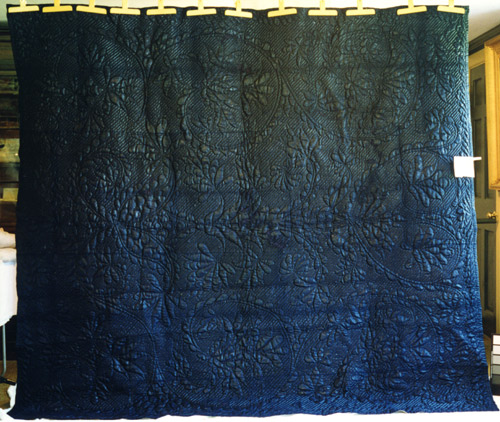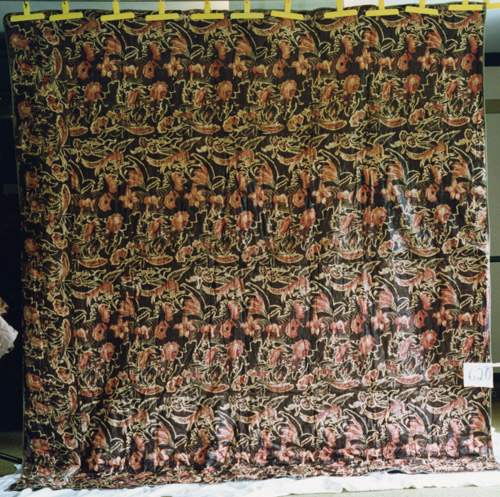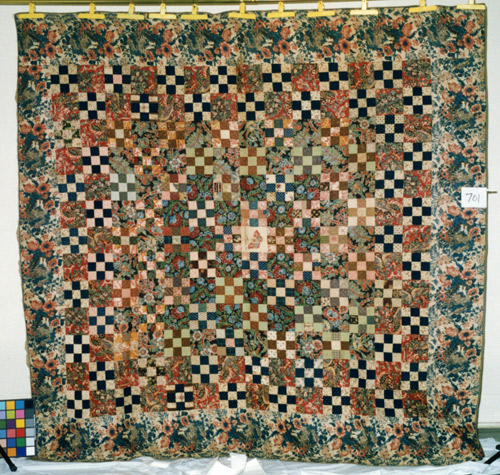BACK TO ESSAYS
Rhode Island’s Early Quilts
The Rhode Island Quilt Documentation Project brought to light a substantial number of eighteenth and early nineteenth century quilts that represent how quilts and quilting developed in the Ocean State. Rhode Island’s many streams and rivers were well suited to the industrial revolution in textiles, and mills specializing in spinning, weaving, bleaching, dyeing, and printing sprang up along waterways across the state. As every schoolchild knows, Rhode Island is home to the nation’s first textile mill, Slater Mill, which began manufacturing cotton yarn in the city of Pawtucket in 1790. This technological involvement in textile manufacturing, as well as Rhode Island’s coastal location, afforded quilters a wide variety of materials with which to create quilts. This essay discusses quilt styles popular in Rhode Island up to 1850 as evidenced by the Rhode Island Quilt Documentation Project (RIQDP) database.
Quilted Petticoats and Petticoat Quilts
The earliest quilted objects in Rhode Island may have been petticoats rather than bed covers. Several quilted petticoats with provenance to the state survive. The earliest, dated 1745, was made for Elizabeth Tripp of Kingston. Two others can be traced to the Gorton family, founders of the city of Warwick. All three are made from brown wool fabric and display closely quilted borders that cause the designs to stand out. The three professional seamstresses who made Tripp's petticoat averaged eighteen quilting stitches per inch, while the Gorton women managed only eight-to-eleven stitches per inch.

Susannah Gorton's Quilted Petticoat
Susannah Gorton
Warwick, Rhode Island
1770
Collection of the John Brown House Museum acc.#RIHS 1982-76.2
Susanna E. Gorton, who married in 1717, stitched images of lions, birds, trees, and pineapples into hers with the initials "GSE".
Such petticoats showed off the considerable needlework skills of their wearers. Not all quilted petticoats were made by their wearers or by local seamstresses, however. Quilted petticoats of varying qualities were imported to the colonies from London, as described by Beverly Lemire.
A quilted petticoat was not underwear like a modern-day slip. It was worn as a skirt under a long gown that opened in the front, or with a short gown that ended below the waist, so that the needlework showed. Such petticoats kept women warm in drafty, un-insulated post-and-beam houses in which the only warmth came from fireplaces. Women of all social classes wore quilted petticoats as shown in the following two examples. A member of the John Brown family, whose brick mansion graces Providence’s East Side, owned a rose-pink wool petticoat that was later made into a quilt. A Native American slave woman by the name of Vice Hill was wearing a black quilted petticoat and striped short gown when she ran away from her master, as described in the 1760 Newport Mercury advertisement seeking her return.
Styles in fashion changed after the French Revolution. By the early nineteenth century, quilted petticoats and open-fronted gowns were passé. A few quilted petticoats from the first half of the nineteenth century survive, but the stitching is crude compared to the eighteenth-century examples, and it is likely that they were worn under full-skirted dresses for warmth. Thrifty Rhode Islanders repurposed the out-of-date petticoats for use on beds. They unpicked the seams, reassembled the pieces as centers of bed covers, and added borders.

Petticoat Quilt
Maker unknown
Portsmouth, Rhode Island
1830s
Private Collection
A Portsmouth gentlewoman whose husband was a judge may have been the owner of a magnificent petticoat that was made into a quilt circa 1830 and gifted to a young bride. The eighteenth-century center, which features a tree of life, animals, birds, and human figures, is done with backstitching that ranges from thirteen to twenty-nine stitches per inch; it produced a much finer line than the straight clamshell stitching of only seven stitches per inch in the newer border.
Whole Cloth Quilts
Rhode Island's numerous whole cloth quilts were constructed from a variety of fabrics. These included solid-colored wools and cottons as well as printed fabrics made from cellulosic fibers. (Cellulosic fibers come from plants, usually flax or cotton.)

Whole Cloth Quilt
Maker unknown
Rhode Island
c1800
Collection of the Little Compton Historical Society
Wool quilts were made from glazed calamanco, which could have been imported or made locally. Although calamanco came in a range of colors, indigo blue tops with pale yellow backs dominated this category in the RIQDP database. One tan quilt from the University of Rhode Island Collection was reputedly made from homespun wool and glazed with an egg white wash. Fiber identification tests performed by Tora Sterregaard revealed that every fiber in the tan quilt top, bat, back, and sewing thread was wool.
All-white whole cloth quilts reflected the neoclassical taste that dominated Europe and America after the turn of the eighteenth century. The RIQDP database includes all-white quilts made from India muslin, Marseille quilts, and summer bedcovers embellished with candle wicking.

Wholecloth Whitework
Mary Talbot
Rhode Island
1807-1808
Collection of the Smith Castle acc.#TE 11
Mary Talbot of Wickford, a seaside village on Narragansett Bay, made her whitework quilt in 1807-1808 from India muslin.
Printed whole cloth quilts showed off the latest textile designs from England and France. The early ones were printed with blocks or copper plates on cotton/flax fabrics. The fabrics were often of mixed fiber content, meaning that each yarn contained both cotton and flax fibers. Mary Beth Gale and Margaret Ordoñez discovered this hitherto unknown fact through fiber identification tests performed at the University of Rhode Island.

Blue Resist Wholecloth
Maker unknown
Rhode Island
1770
Collection of the John Brown House Museum acc.#RIHS 1994.15.1
A blue and white resist print, which dates to approximately 1750, was printed on this type of mixed cotton/flax fabric. The resist technique involved printing a resist paste onto a cellulosic fabric. The fabric was then dipped into a cold-water vat of indigo, which colored the exposed sections blue when the dye made contact with the air.

Wholecloth Quilt
Maker unknown
Rhode Island
pre-1799
Collection of the Rhode Island School of Design acc.#RISD 1954-179
Copperplate prints in monochrome colors--red, blue, or brown--featured prominently in Rhode Island quilts. Such textiles were imported, mostly from France where Cristophe-Philippe Oberkampf originated these distinctive fabrics at the printworks he founded on the river Jouy. Known as toiles, they are characterized by large scenic designs. Copperplate prints were especially popular in the late eighteenth century for bed hangings. Sometimes a matching quilt or counterpane for a four-poster bed was included. When bed hangings started to look worn, Rhode Islanders sometimes cut them up and used the good sections for patchwork.

Whole Cloth Bird Print Quilt
Maker unknown
Little Compton, Rhode Island
1800-1825
Collection of the Little Compton Historical Society
Also popular were whole cloth quilts made from floral or bird prints. These were mostly block-printed cottons, but plate and cylinder prints were also used. An English chintz, at one time an eighteenth-century dress, was made into a quilt by Grandma Petty, brought to Rhode Island in 1820, and passed down through the women in the family. The fabric is block printed with areas of hand painting called penciling. Bird prints appear with regularity.
These prints, which feature birds on branches or facing urns, enjoyed prominence in the early decades of the nineteenth century. Rhode Islanders continued to make whole cloth quilts in the second half of the nineteenth century after inexpensive cylinder prints became readily available.
Strip Quilts
Reflecting their British heritage, Rhode Island’s early quiltmakers sewed strips of fabrics together to create strippies similar to those made by women in the north of England (Osler 1987). The strips could be either solids or prints, or combinations thereof.

Strip Quilt
Maker unknown
pre-1799
Collection of the Varnum House acc.#Q004
A strip quilt at Varnum House in East Greenwich exhibits a small geometric print alternating with two larger prints, including one yellow fabric with a Greek key design that resembles English prints from the last decade of the eighteenth century. Related to simple strip quilts are those with pieced strips, exemplified by the pattern known as Flying Geese.

Flying Geese
Maker unknown
Rhode Island
1835-1845
Collection of the Babcock-Smith House Museum
Other pre-1850 strip quilts in the RIQDP database feature familiar patterns such as star or nine-patch in the patchwork strips.
Patchwork: Medallion/Frame
Experimentation with patchwork led to a style known as a medallion or frame quilt. Like strip quilts, medallion quilts were made in England; some date to the eighteenth century. Concentric frames create the design instead of repeating a block for an overall pattern. A variety of basic patchwork patterns emerge from such quilts; triangles and squares are sewn together to form simple blocks, as well as four-patch, nine-patch, and star designs.

Medallion
Elizabeth Almy Bailey Stanhope
Newport, Rhode Island
c1840
Private Collection
The very first quilt in the RIQDP database is a medallion quilt made (and re-made) circa 1840. The newer medallion section was sewn onto a faded and worn older quilt made from an early nineteenth century red toile by Elizabeth Almy Bailey Stanhope.
Patchwork: Block

Nine Patch
Ann Thankful Mathewson
Rhode Island
1815
Collection of the Rhode Island School of Design acc.#RISD 1939.005
The RIQDP discovered many early block-style quilts in cotton or wool. The earliest dated one is a magnificent nine-patch quilt made by Ann Thankfull Mathewson of Providence. Her name and the date "1815" surrounds an appliqué chintz butterfly in the center block. Nine-patch blocks alternate with unwashed, glazed imported chintz blocks. The quilt has a border of another flowered chintz.
Early nineteenth-century patchwork quilts were made for large beds, often with four posters. Rhode Island quiltmakers cut out the corners to accommodate the bedposts at the foot of the bed. These quilts sometimes measure over 100 inches in both directions. The most popular block patterns were four patch, nine-patch, and star, sometimes with a straight set, sometimes on point. These quilts are spectacular examples of the variety of printed fabrics available before 1856 when William Perkin discovered mauve, the first aniline dye. Rhode Island was one of the leading manufacturers of printed cottons along with Massachusetts, New Hampshire, and Pennsylvania. The dyers of the day achieved a remarkable range of colors using plant materials such as indigo, madder, and various woods; dried insects like cochineal; and minerals. Extant dye receipt books from dyers who worked in Rhode Island, particularly Samuel Dunster, reveal that more than one recipe could create a similar result. The recipe books also show the extent of cooperation between American and English dyers.

Sixteen Patch of Printer's Trials
Possibly Isabella Allen
Hope, Rhode Island
1830s
Collection of the Historic Textile and Costume Collection at the University of Rhode Island acc.#URI 54.39.186 (Patchwork #27)
After closely examining the prints in certain quilts, Margaret Ordoñez and I surmised that they were made with waste fabrics from printer’s trials that would ordinarily have been thrown away . These quilts exhibit identical prints in different colorways, suggesting that men or women with connections to Rhode Island’s many printworks salvaged the fabrics for utility quilts. Some patches have printing flaws known as "scrimps." For a discussion of one of these quilts, see the article entitled “Early Calico Printing in Rhode Island” in Uncoverings.
Hexagon
Another early patchwork style is made from hexagon-shaped pieces backed with paper templates. The hexagons are sewn together in units, then assembled into a whole. Sometimes the hexagons are quilted, other times not. Occasionally the paper remains, which aids in dating such quilts since the templates were cut from old letters, envelopes, or newspapers. This style is also called mosaic or honeycomb, and it is an example of the English paper piecing technique. In the twentieth century, the hexagon style was revived as Grandmother’s Flower Garden.
The earliest example in the RIQDP database is a cotton quilt dated 1807, well before Godey’s Lady’s Book published the pattern for this type of quilt in 1835. One hexagon quilt even had a handwritten piece of paper attached that stated: “Godey’s Lady’s Book came out with this pattern.”

Hexagon
Lydia Braman Peabody
Middletown, Rhode Island
c1845-1870
Private Collection
Two spectacular examples of hexagon work were brought to a public documentation day by a 90-year-old woman whose grandmother, Lydia Braman Peabody (a descendant of Elizabeth Peabody of Mayflower fame), had made nine quilts one for each of her children. As is the case with so many hexagon quilts, the maker left one unfinished; it was finally backed in 1980.
Appliqué
No appliqué quilts with a firm Rhode Island provenance survive from the years prior to 1850. Does this mean that Rhode Island quiltmakers did not make appliqué quilts? Were they perhaps too thrifty to cut up perfectly good fabric to sew onto quilt tops? To answer these questions, we may look at quilts from Rhode Island’s two neighboring states. The Connecticut Quilt Search did uncover some appliqué quilts dated before 1850 with provenance to the state. However, Massachusetts did not find very many. Only three appliquéd quilts in Massachusetts Quilts: Our Common Wealth and Northern Comfort are documented to the first half of the nineteenth century; two are dated circa 1840 and the third is dated circa 1850. Regardless of whether the lack of early appliqué quilts in the RIQDP database is fact or a fiction, we can say with certainty that Rhode Islanders showed a marked preference for patchwork quilts in the first half of the nineteenth century.

Starburst
Phoebe Hall
West Grenwich, Rhode Island
c1840
Private Collection
Rhode Island quiltmakers attempted complex patchwork patterns with excellent results: Phoebe Hall of West Greenwich made Starburst, a variation on Mariner’s Compass and Sunburst, with wool fabrics. Such well-made quilts reveal that it was not for lack of skill that patchwork was preferred over appliqué.
A Regional Style?
The possibility of regional styles in American quilts is a notion borrowed from folklore studies. We know that album quilts reached a pinnacle in Baltimore, that signature quilts probably developed in the Delaware Valley, and that quilts with cut-out corners are found only in New England. Did Rhode Island develop a distinctive quilt style? Or, at the very least, is a southern New England style discernable?
The RIQDP recorded many patchwork quilts dated before 1850 with similar characteristics. These characteristics are as follows: patchwork, block style, on point, sashing, and borderless. This style could be considered a typical Rhode Island quilt.

Title
Seventh Day Baptist Female Benevolent Society
Westerly, Rhode Island
1846
Private Collection
One example, a Chimney Sweep album quilt made by members of the Seventh Day Baptists Female Benevolent Society in 1846, exhibits the variety of cylinder prints available in Rhode Island by mid century. Discovered inside a 1920s quilt, it is well suited to the conservative New England temperament of use it up, wear it out, make it do, or do without. The most common patchwork patterns--four patch, nine-patch, and star--continued to be pieced well into the second half of the nineteenth century and set on point into borderless tops, further strengthening the argument that Rhode Island did develop a regional style.
Linda Welters
August 2011
All rights reserved
Resources
Bassett, Lynne Zacek (ed.) Massachusetts Quilts: Our Common Wealth. Lebanon: New Hampshire, 2009.
Bassett, Lynne Z., and Larkin, Jack. Northern Comfort: New England's Early Quilts, 1780-1850. Nashville, TN: Rutledge Hill Press, 1998.
Baumgarten, Linda. "The Layered Look: Design in Eighteenth-Century Quilted Petticoats." Dress 34 (2007): 7-31.
Connecticut Quilt Search Project. Quilts and Quiltmakers: Covering Connecticut. Atglen, PA: Schiffer Publishing, 2001.
Gale, Mary Elizabeth, and Margaret T. Ordoñez. "Eighteenth-Century Indigo-Resist Fabrics: Their Use in Quilts and Bed Hangings." Uncoverings 2004, Volume 25 of the Research Papers of the American Quilt Study Group, 159-179.
Lemire, Beverly. "Redressing the History of the Clothing Trade in England: Ready-Made Clothing, Guilds, and Women Workers, 1650-1800." Dress 21 (1994): 61-74.
Ordoñez, Margaret T. and Linda Welters. "Nineteenth-Century Album Quilts in Rhode Island." What's American About American Quilts - A Research Forum on Regional Characteristics, II: 10-17. Washington, D.C.: Smithsonian Institution, 1997.
Osler, Dorothy. Traditional British Quilts. London: B.T. Batsford, 1987.
Welters, Linda and Margaret T. Ordoñez, eds. Down by the Old Mill Stream: Quilts in Rhode Island. Kent, OH: Kent State Press, 2000.
Welters, Linda and Margaret T. Ordoñez, "Early Calico Printing in Rhode Island." Uncoverings 2001: Volume 22 of the Research Papers of the American Quilt Study Group, 65-85.
-
Documentation Project
Rhode Island Quilt Documentation Project University of Rhode Island
-
Pre-1799
Susannah Gorton's... Gorton, Susanna E.
-
1830s
Petticoat Quilt -
1800-1849
Whole Cloth Quilt... -
1800-1849
Whole Cloth White... Talbot, Mary
-
Pre-1799
Blue Resist Whole... -
Pre-1799
Whole Cloth Quilt... -
1800-1849
Whole Cloth Bird ... -
Pre-1799
Strip Quilt -
1800-1849
Flying Geese -
1800-1849
Medallion Stanhope, Elizabeth...
-
1800-1849
Nine Patch -
1800-1849
Sixteen Patch of ... Allen, Isabella-pos...
-
1850-1875
Hexagon Peabody, Lydia Bram...
-
1800-1849
Starburst Hall, Phoebe
-
1800-1849
Chimney Sweep Seventh Day Baptist...
Load More